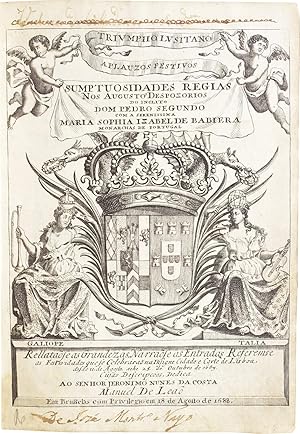Beschreibung
4°, twentieth-century (second or third quarter) blind-tooled calf (slight wear), spine with raised bands in five compartments, two crimson leather lettering pieces in second and fourth compartments, gilt letter (title), edges sprinkled red from an earlier binding. Engraved title page with arms of the newly married couple, 2 putti holding banners, and two women labeled Galiope [sic] and Talia (see below). A few light stains; tiny wormhole in last 5 quires, touching one letter per page. Overall in very good to fine condition. Old signatures on title page, in upper (scored) and lower ("De Jozé Montrº Nayo") margins. Engraved title page, (4 ll., including errata on final verso), 328 pp. *** FIRST and ONLY EDITION. This verse narrative describes the festivities - including illuminations, triumphal arches, bonfires and bullfights - celebrated in Lisbon upon the marriage of D. Pedro II (1648-1706) to Maria Sophia Isabella (1666-1699), daughter of Philipp Wilhelm of Neuburg, Count Palatine. In the prologue, the author notes that the royal nuptials can be better described by a poem than by a prose narrative: "Bem sey que as excelencias destes Regios Nupciais Elogios, mais erão Sugeito para as eloquencias de hum Poema, do que materia para as limitações de huma Rellação." (f. A3v). The 92 ramos give lengthy poetic descriptions of Maria Sophia's arrival in Lisbon, a day of bullfights (pp. 159-252), a fireworks display (pp. 253-290), and a second day of bullfights (pp. 291-328). Each section of the poem is preceded by a few lines in italic explaining the upcoming "scene," often giving details of the actors, sets, costume, and gold and silver ornaments. For example: "No meyo deste Cerco, se levantava huma Belligera fortaleza com quatro soberbos Baluartes, & oito vistozas Guaritas, Coroandose com hum Eminente Castello; viãose em Contorno sobre as agoas, muitos Marinhos gigantes armados com lanças & Rodellas, donde violentos se ocultavão engenhosos fogos" (p. 260).The charming title page incorporates the combined arms of D. Pedro II and his wife, surmounted by a large crown. Out of the crown stretch a dragon and a large bird who hold wreaths over the women who flank the arms. On the left, "Galiope" (sic, for Calliope, muse of epic poetry) is crowned with a globe and cross that bears the name Maria, and holds a trumpet in her right hand. On the right is Talia (Thalia, muse of comedy), crowned with a globe bearing the name Pedro, and holding a stringed instrument. Above the arms and the muses, two putti hold three banners bearing part of the title. The end of the author's prologue explains the use of these two figures: "Na severidade de Reays, não perdem os Epithalamios condição de festivos; neste que te aprezento, adorno o seriozo com as galas do alegre; valhome do heroyco de CALIOPE, sem desprezar o agradavel de TALIA: com o Clarim daquella, expecifico as grandezas; com o Plectro desta, solemnizo os festejos" (f. A4r).D. Pedro II of Portugal (1648-1706) was the second surviving son of D. João IV. From 1668 he was regent for his elder, mentally deficient brother, D. Afonso VI, whom he exiled to the Azores and later Sintra, where Afonso died in 1683. Afonso's marriage to Maria Francisca of Savoy had meanwhile been annulled because it had never been consummated. Pedro married his former sister-in-law in 1668, and she bore him a daughter, Isabel Luísa Josefa de Portugal, who became heir to the throne. The combination of D. Isabel's poor physical health and the strict rules for succession to the Portuguese throne led to canceled engagements with royal offspring across Europe, earning her the nickname "a Sempre-Noiva," "the ever-engaged." When Maria Francisca died in 1683, D. Pedro aimed to secure the succession by marrying into a famously fecund and well-connected family. He dispatched Manuel da Silva Teles to Heidelberg to request the hand of Maria Sophia, daughter of the Count Palatinate, sister of Eleanor Madeleine, third wife of Leopold I of A. Bestandsnummer des Verkäufers 22032
Verkäufer kontaktieren
Diesen Artikel melden
![]()



